TODAY’S EXPECTATIONS ARE TOMORROW’S STANDARDS – THEME FOR SEMINAR 1 OF INAUGURAL 2008 COMOX VALLEY LEARNING LUNCH SERIES: “In the last 15 to 20 years, we have seen dramatic changes in the Comox Valley in terms of land use; and rainwater effects on the environment have been dramatic,” stated Ian Whitehead when he provided context for evolution of engineering practices (September 2008)
Note to Reader:
The City of Courtenay was the host municipality for the second series of pilot Vancouver Island Learning Lunch Seminars. The series promoted a consistent provincial approach to rainwater management and green infrastructure.
The meet-and-greet for each Learning Lunch Seminar started at 10:30am. Each event concluded at 3:00pm. The first Comox Valley seminar was held on September 19th 2008. To download the agenda, click here. The series comprised three events:
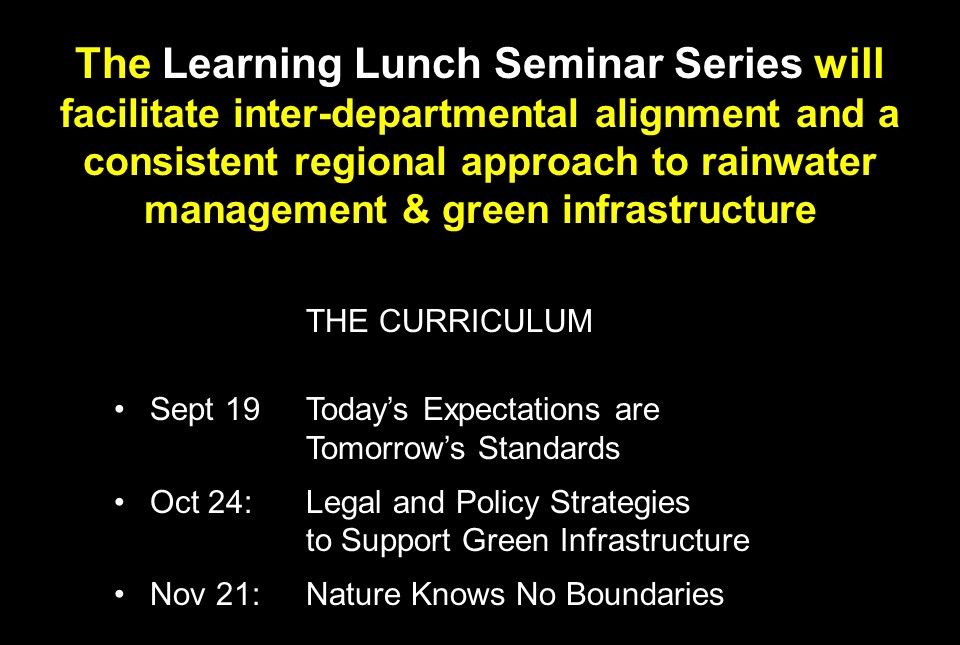
Create Liveable Communities & Protect Stream Health: To get to the big picture, it starts with the smallest pieces
The Province is leveraging its grants programs to influence changes on the ground. British Columbia is in transition. Today, assessment criteria are based on a philosophy of “the greener the better”. Tomorrow, all projects must meet a green standard. The Province’s position is clear: Adapting to climate change and reducing our impact on the environment will be a condition for receiving provincial infrastructure funding
Key Messages
Two key messages shaped the approach to informing, educating and enabling participants.
- Doing more with less; and
- To get to the big picture, it starts with the smallest pieces.
The approach to series design is to start simply by highlighting key messages and examples that promote a common understanding; and progressively build to the regional picture. The ultimate goal is collaboration and integration that results in innovation in implementing policies and practices that create liveable communities and protect stream health.
To Learn More:
Participants were provided with a list of web links for 24 references – guidance documents, web sites, web documents, magazine articles and announcements – so that they would have a library of resources at their fingertips. Download a copy of Rainwater Management & Green Infrastructure in British Columbia: List of Web Resources.
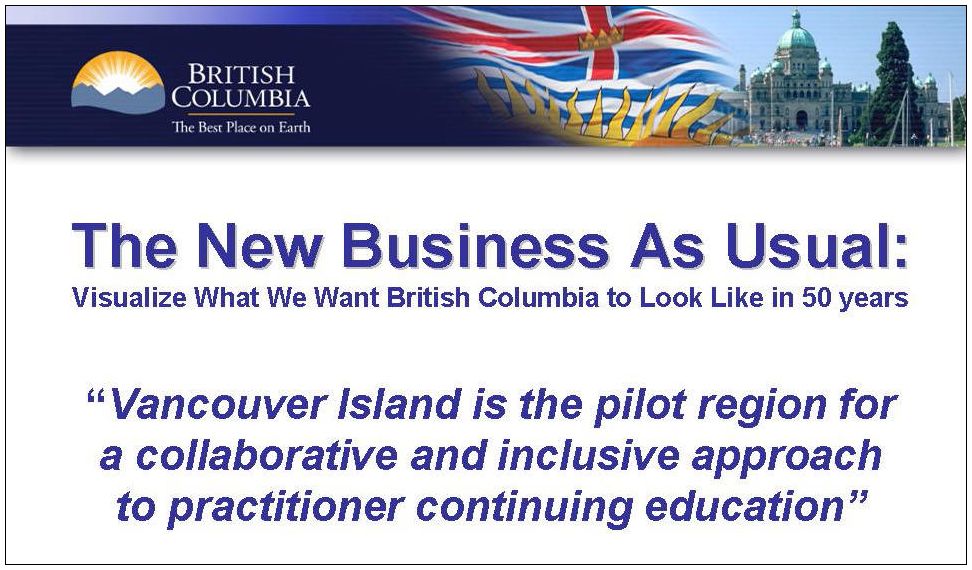
Today’s Expectations are Tomorrow’s Standards
The first Comox Valley seminar on September 19th 2008 was introductory in scope, with the objective of stimulating the interest of participants in doing self-exploration by digging into a list of web resources at their leisure. The seminar theme was: “Today’s Expectations are Tomorrow’s Standards”.
“At Seminar #1, my series opening presentation traced the evolution of rainwater/stormwater management policies and practices over the past decade. This was designed to provide a frame-of-reference and a common understanding for subsequent sessions,” stated Kim Stephens, Program Coordinator for the Water Sustainability Action. He designed the series curriculum and moderated the seminars.
 “Because I was project manager and principal author of Stormwater Planning: A Guidebook for British Columbia, I explained the approach and structure so that participants would know how to use it effectively as a planning resource and/or tool.
“Because I was project manager and principal author of Stormwater Planning: A Guidebook for British Columbia, I explained the approach and structure so that participants would know how to use it effectively as a planning resource and/or tool.
“We introduced the the phrase ‘design with nature’ so that participants would understand why a Design with Nature approach to rainwater management (i.e. using infiltration and trees) will influence the greening of the built environment and protect stream health.
“A set of four presentations provided context for the day and set the scene for a walkabout through the Glacier View Pond area in East Courtenay. After the walkabout, and with the assistance of Kate Miller of the Cowichan Valley Regional District, I delved into the details of the Guidebook and how the Water Balance Model had been developed as an extension of the Guidebook.”
To Learn More:
Download a copy of Creating Our Future – The New Business As Usual (Visualize What We Want Vancouver Island to Look Like in 50 Years), the presentation by Kim Stephens that opened the day.

The Story of East Courtenay
 Ian Whitehead followed Kim Stephens on the agenda and recounted the history of East Courtenay. This primed participants for the Glacier View walkabout.
Ian Whitehead followed Kim Stephens on the agenda and recounted the history of East Courtenay. This primed participants for the Glacier View walkabout.
“The walkabout provided an on-the-ground illustration of how the engineering approach to detention pond design has evolved in response to changing expectations,” stated Ian Whitehead.
To Learn More:
Download a copy of The Story of East Courtenay over the past 20 years: from fields and forest to urban community, the PowerPoint presentation by Ian Whitehead.
YouTube Videos
In this first 10-minute clip, Ian Whitehead introduced the evolution theme and drew on his experience over 20 years to provide context for the Glacier View case study. He reflected on changes in drainage practice as he has implemented in East Courtenay over the past two decades.
In the second 10-minute clip, Ian delved into the next level of detail in terms of illustrating what the evolution in drainage practices looks like on the ground in Courtenay. The emphasis was on how to achieve a water balance through ground infiltration of rainwater runoff.
In the final 9-minute clip, Ian set the stage for the walkabout by describing the elements of the Glacier View case study. He presented a series of slides taken during construction, completed in 2008.
Helping Goals Become Practice
Catriona Weidman, Ministry of Community Development, provided a provincial overview. She explained both the Living Water Smart and Green Communities initiatives and was structured in three parts: Changing the Rules for Greener Communities; Living Water Smart; and Funding for Green Infrastructure. To both see and hear Catriona’s presentation, watch the YouTube videos.
These will provide viewers with both the flavour and substance of the material that Catriona presented. The first 5-minute video covers Changing the Rules and Living Water Smart. The second video deals with funding.
To Learn More:
Download a copy of Creating Liveable Communities & Protecting Stream Health: Helping goals become practice, the PowerPoint presentation by Catriona Weidman.
YouTube Videos
Stormwater Guidebook, Performance Targets and the Water Balance Model
Download a copy of The New Business As Usual: Stormwater Guidebook, Performance Targets and Water Balance Model, the PowerPoint presentation by Kim Stephens.
YouTube Videos
In this first 10-minute segment, Kim set the scene for the current “Beyond the Guidebook” initiative. The emphasis was on key messages that capture the essence of the outcome-oriented Guidebook: “This is what we want.”
In the second 10-minute segment, Kim explained how lessons learned since publication of the Stormwater Planning Guidebook in 2002 have been incorporated in the “Beyond the Guidebook” initiative: “What we once believed to be unachievable is now within our grasp,” he emphasized.
In the third 10-minuted segment, Kim introduced a generic application of the web-based Water Balance Model to illustrate how users can readily quantify performance targets for rainwater runoff on a single family residential property.
Walkabout – You Tube Videos
The City of Courtenay prepared a brochure complete with aerial photo to highlight the points of interest along the walkabout route between Valley View Drive and Evans Place. To download a copy, please click on Glacier View Walkabout Brochure. Then click on the YouTube links below for a series of commentaries by Kevin Lagan (Director of Operational Services), Derek Richmond (Manager of Engineering) and Ian Whitehead (consulting engineer):
At Location #1 on the walkabout, Kevin Lagan, with assistance from Ian Whitehead (the engineer of record for the project), explained the development history of the Hawk-Glen Park & Water Retention Pond, constructed in 1993.
Standing next to the creek/ditch that feeds Glacier View Pond (constructed in 2008), Kevin Lagan and Derek Richmond tag-teamed to explain the development of the Glacier View Detention Pond.
Derek RIchmond emphasized how the CIty has achieved more with less in order to set the scene for Ian Whitehead to explain some of the details of pond construction, with emphasis on working with and blending in with nature.
At Location #4, Derek Richmond described the City’s thinking with respect to the design of the outlet works for the Glacier View Detention Pond; with emphasis on liability concerns and mitigation of risk through proactive measures.
At Location #3, Ian Whitehead explained how necessity during construction resulted in a simple but elegant solution which involved diverting stormwater/rainwater runoff into the forest onto an interim basis such that natural infiltration prevented any downstream consequences.
At the same Location #3, Kevin Lagan explained the considerations that led to conversion of the Sheraton Road right-of-way into a paved bikeway. and resulted in environmental and other benefits that contribute to the liveability of the surrounding neighbourhoods.
Also at Location #3, Kevin Lagan explained how the decision was made by the City to purchase a 20-acre forest experimental research area from the Province, and retain the land as green space rather than develop it for housing. It now serves an ecosystem function.
At Location #5, the Brookmere Subdivision, the City of Courtenay engineering team explained how the City is implementing changes in the way land is developed. The change in approach starts with the role of the building inspector.
Photographs




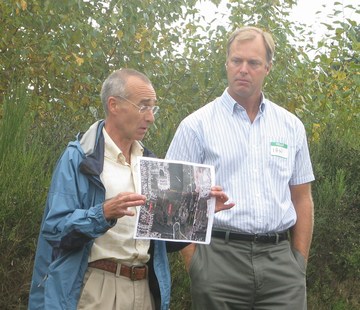
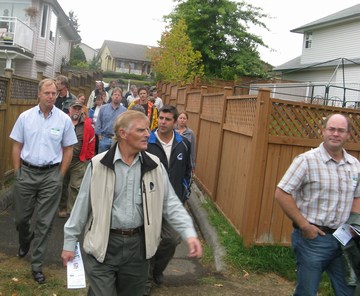

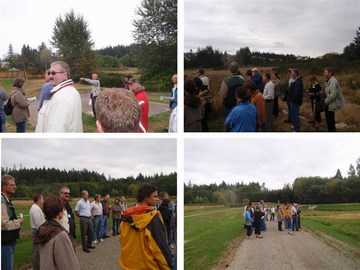
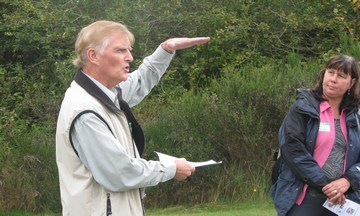






 Cross-Country hike from Hawk-Glen Park & Water Retention Pond. Moving in a southwesterly direction away from the residential area and towards the creek/ditch that brings water from Cumming Road the pond.
Cross-Country hike from Hawk-Glen Park & Water Retention Pond. Moving in a southwesterly direction away from the residential area and towards the creek/ditch that brings water from Cumming Road the pond.